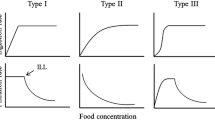Abstract
The condition index (CI) of the clam Rangia cuneata was measured monthly at 8 stations in 2 substrate types and 3 salinity regimes in the James River estuary, Virginia, USA. CI was higher in clams from sand bottoms than from mud, and decreased in both substrata in fresher water. Values were lowest in early spring and at a maximum in early autumn, with a pronounced autumn peak in the sand substratum. This pattern coincided with the annual salinity cycle. A field experiment showed that some factor associated with the water overlying a sand or mud substratum, rather than the nature of the substratum itself, was important in determining CI. The hypothesis is presented that this factor may be the higher suspended solids concentrations measured immediately over mud bottoms.
Similar content being viewed by others
Literature Cited
Baird, R.H.: Measurement of condition index in mussels and oysters. J. Cons. perm. int. Explor. Mer 23, 249–257 (1958)
Bedford, W.B. and J.W. Anderson: The physiological response of the estuarine clam Rangia cuneata (Gray) to salinity. I. Osmoregulation. Physiol. Zoöl. 45, 255–260 (1972)
Cain, T.D.: Reproduction and recruitment of the brackish water clam Rangia cuneata in the James River, Virginia. Fish. Bull. U.S. 73, 412–430 (1975)
Chipman, W.A.: Seasonal changes in the fattening of oysters. Conv. Addr. natn. Shellfish. Ass. 1947, 28–32 (1947)
Engle, J.B.: The condition of oysters as measured by the carbohydrate cycle, the condition factor and the percent dry weight. Proc. natn. Shellfish. Ass. 41, 20–25 (1950)
— The seasonal significance of total solids of oysters in commercial exploitation. Proc. natn. Shellfish. Ass. 48, 72–78 (1957)
Fairbanks, L.D.: Biodemographic studies of the clam Rangia cuneata Gray. Tulane Stud. Zool. 10, 3–47 (1963)
Gallagher, J.L. and H.W. Wells: Northern range extension and winter mortality of Rangia cuneata. Nautilus 83, 22–25 (1969)
Galtsoff, P.S.: The American oyster Crassostrea virginica Gmelin. Fishery Bull. Fish Wildl. Serv. U.S. 64, 1–480 (1964)
Haven, D.: Seasonal cycle of condition index of oysters in the York and Rappahannock Rivers. Proc. natn. Shellfish. Ass. 51, 42–66 (1960)
Hopkins, S.H., J.W. Anderson and K. Horvath: The brackish water clam Rangia cuneata as indicator of ecological effects of salinity changes in coastal waters, 250 pp. Rep. to U.S. Army Corps of Engineers, Waterways Experiment Station, Vicksburg, Mississipi, Contract Rep. H-73-1 (1973)
— and J.D. Andrews: Rangia cuneata on the east coast: thousand mile range extension or resurgence? Science, N.Y. 167, 868–869 (1970)
Korringa, P.: Recent advances in, oyster biology. Q. Rev. Biol. 27, 266–365 (1952)
Loosanoff, V.L.: Effects of turbidity on some larval and adult bivalves. Proc. Gulf Caribb. Fish. Inst. 14, 80–95 (1961)
— and J.B. Engle: Effect of different concentrations of microorganisms on the feeding of cysters (O. virginica). Fishery Bull. Fish Wildl. Serv. U.S. 51, 31–57 (1947)
Medcof, J.C. and A.W.H. Needler: The influence of temperature and salinity on the condition index of oysters (Ostrea virginica). Fish. Res. Bd Can. 5, 253–257 (1941)
Peddicord, R.K.: Growth and condition of Rangia cuneata in the James River, Virginia, 116 pp. Ph.D. Thesis, University of Virginia, Charlottesville, Va. 1973
— Effects of substratum on growth of the bivalve Rangia cuneata Gray, 1831. Veliger, 18, 398–404 (1976)
Pfitzenmeyer, H.T.: Project C. Benthos. Spec. Rep. Univ. Maryl. nat. Resour. Inst. 3, 26–38 (1970)
— and K.G. Drobeck: The occurrence of the brackish water clam, Rangia cuneata, in the Potomac River, Maryland. Chesapeake Sci. 5, 209–215 (1964)
Picken, L.E.R.: The mechanism of urine formation in invertebrates. II. The excretory mechanism in certain molluscs. J. exp. Biol. 14, 20–34 (1937)
Potts, W.T.W.: The energetics of osmotic regulation in brackish and freshwater animals. Biol. Bull. mar. biol. Lab., Woods Hole 31, 618–630 (1954)
Pratt, D.M. and D.A. Campbell: Environmental factors affecting growth in Venus mercenaria. Limnol. Oceanogr. 1, 2–17 (1956)
Richards, H.G.: Animals of the seashore, 29 pp. Boston: Bruce Humphries 1938
Tenore, K.R., D.B. Horton and T.W. Duke: Effects of bottom substrate on the brackish water bivalve Rangia cuneata. Chesapeake Sci. 9, 238–248 (1968)
Wass, M.L.: A checklist of the biota of lower Chesapeake Bay, Spec. scient. Rep. Va Inst. mar. Sci. 65, 1–290 (1972)
Wells, H.W.: The fauna of oyster beds with special reference to the salinity factor. Ecol. Monogr. 31, 239–266 (1961)
Woodburn, K.D.: Clams and oysters in Charlotte County and vicinity. Bull. Fla St. Bd Conserv. mar. Lab. No. 62-12, 1–29 (1962).
Author information
Authors and Affiliations
Additional information
Communicated by J.S. Pearse, Santa Cruz
Virginia Institute of Marine Science Contribution No. 782.
Rights and permissions
About this article
Cite this article
Peddicord, R.K. Salinity and substratum effects on condition index of the bivalve Rangia cuneata . Mar. Biol. 39, 351–360 (1977). https://doi.org/10.1007/BF00391938
Accepted:
Issue Date:
DOI: https://doi.org/10.1007/BF00391938




